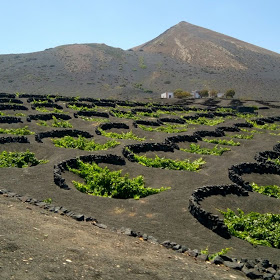An interesting read written by José Ángel Macho Barragués. Agricultural engineer.
JULY 16, 2017
LANZAROTE, A landscape modeled by the wind, volcanoes and their peasants
The fourth island on the surface of the Canarian archipelago is the territory where there is a greater influence of the volcanic activity that gave origin to this magnificent group of islands. Cataloged as a Biosphere Reserve since 1993 by Unesco, the frenzied activity carried out by the artist Cesar Manrique shaped a landscape in which architecture is fully integrated with nature. The majos, North African town of Berber origin, populated this territory from the year 500 BC until the XV century in which it was conquered by the troops sent by the king Enrique III of Castile, happening to be a feudal manor, time in which it underwent a Constant siege by piracy given its isolation and length of its coasts.

Much of its territory dominates a silent lunar landscape of volcanic origin with certain nuances that give it a unique singularity. The influence of the peasants has had a very important landscape contribution since time immemorial, still present today, has its maximum splendor in the area of La Geria, where fertile lands are flooded with ash in which have been planted grape vineyards Malvasia excavating in the ground holes of about 20 cm of depth and protecting the strains of the strong wind with some semicircular stone walls characteristic. Volcanism finds its maximum expression in the National Park of Timanfaya and in the Natural Park of the Volcanoes, landscape purely dominated by craters, ashes, Mountains of fire and solidified lava where time seems to have stalled and there are scarcely any signs of life in an arid and desert land. The island itself is adorned by a very scarce flora adapted to the sparse rain, where the sweet Tabaiba stands out and the more than 200 species of lichen that have been aduanando to the volcanic rock, also exist although they are rare, arboreal representatives, above all In the valley of a thousand palm trees in the town of Haria. In the garden of the cactus can be contemplated hundreds of species although its great majority are exotic. The fauna is reduced to different birds such as the canary or hoopoe, small rodents, the nice perequén and the emblematic and unique in the world blind crab Los Jameos. The island itself is adorned by a very scarce flora adapted to the sparse rain, where the sweet Tabaiba stands out and the more than 200 species of lichen that have been aduanando to the volcanic rock, also exist although they are rare, arboreal representatives, above all In the valley of a thousand palm trees in the town of Haria. In the garden of the cactus can be contemplated hundreds of species although its great majority are exotic. The fauna is reduced to different birds such as the canary or hoopoe, small rodents, the nice perequén and the emblematic and unique in the world blind crab Los Jameos. The island itself is adorned by a very scarce flora adapted to the sparse rain, where the sweet Tabaiba stands out and the more than 200 species of lichen that have been aduanando to the volcanic rock, also exist although they are rare, arboreal representatives, above all In the valley of a thousand palm trees in the town of Haria. In the garden of the cactus can be contemplated hundreds of species although its great majority are exotic. The fauna is reduced to different birds such as the canary or hoopoe, small rodents, the nice perequén and the emblematic and unique in the world blind crab Los Jameos. Especially in the valley of a thousand palm trees in the town of Haria. In the garden of the cactus can be contemplated hundreds of species although its great majority are exotic. The fauna is reduced to different birds such as the canary or hoopoe, small rodents, the nice perequén and the emblematic and unique in the world blind crab Los Jameos.Especially in the valley of a thousand palm trees in the town of Haria. In the garden of the cactus can be contemplated hundreds of species although its great majority are exotic. The fauna is reduced to different birds such as the canary or hoopoe, small rodents, the nice perequén and the emblematic and unique in the world blind crab Los Jameos.

The triptych of El Mirador del río, from where you can see a breathtaking view of the Chínijo archipelago with the island of la graciosa at the head;The cave of the greens and the jameos of the water, both natural excavations in a long tunnel of hollow lava are examples of a unique integrated nature that offers this paradise canary. The beach and the cliffs of Famara, the beaches of Papagayo in the natural environment of the ajaches, the salinas of janubio, the hervideros or the claws lagoon in the gulf are other natural surroundings worthy of visiting. Villages such as Teguise or Yaiza still retain much of their authenticity and invite you to get lost in their streets to enjoy their different mojo sauces or discover their crafts based on the olivine, precious stone carved green of volcanic origin.

The influence of the creator Cesar Manrique and his insistence on the conservation of nature in front of the tourism translated in an endless works scattered throughout the island as his famous wind toys arranged in different locations, sculptures like the Timanfaya demon or his house -museum in the town of Haria. This universal Lanzarote has left as an inheritance an island in which still remain whitewashed white houses adorned with blue and green frames that have resisted the creation of large hotel complexes that could destroy the natural environment.Lanzarote is ideal for renting a vehicle and traveling its roads and paths to get lost in an endless number of towns and landscapes, to practice outdoor sports such as kayaking, surfing or enjoying the famous ironman, International long distance triathlon. Impregnated with aromas ranging from fresh aloe vera to the intense of the solidified ashes, stand out above all its great natural value and common sense that has endured in this spectacular enclave inviting a continuous discovery.
José Ángel Macho Barragués. Agricultural engineer.







